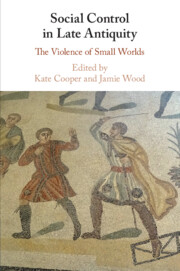Book contents
- Social Control in Late Antiquity
- Social Control in Late Antiquity
- Copyright page
- Contents
- Contributors
- Preface and Acknowledgements
- Abbreviations
- Introduction
- Part I Women and Children First
- Part II ‘Slaves, be subject to your masters’
- Part III Knowledge, Power, and Symbolic Violence
- Part IV Vulnerability and Power
- Bibliography
- Index
Part III - Knowledge, Power, and Symbolic Violence
The Aesthetics of Control in Christian Pedagogy
Published online by Cambridge University Press: 18 September 2020
- Social Control in Late Antiquity
- Social Control in Late Antiquity
- Copyright page
- Contents
- Contributors
- Preface and Acknowledgements
- Abbreviations
- Introduction
- Part I Women and Children First
- Part II ‘Slaves, be subject to your masters’
- Part III Knowledge, Power, and Symbolic Violence
- Part IV Vulnerability and Power
- Bibliography
- Index
Summary
The studies in Part III explore how the Christian preachers and writers of late antiquity used a wide range of pedagogical and literary techniques to evoke empathetic responses in their audiences. Deployed effectively, such techniques could prove pivotal in cultivating both empathy and an imaginative apparatus for thinking about the relationship between individuals and the community to which they belonged, at the same time establishing the authority of the teacher within their particular small worlds, from classroom to monastery and beyond. Yet, making a success of this intermediary position was not easy and, as we shall see, such victories were often hard won in the face of interference from superiors, competition from peers, and the recalcitrance of audiences.
- Type
- Chapter
- Information
- Social Control in Late AntiquityThe Violence of Small Worlds, pp. 171 - 274Publisher: Cambridge University PressPrint publication year: 2020

